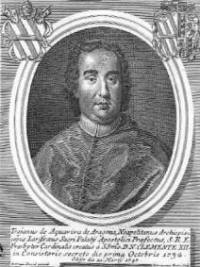Troiano Acquaviva d'Aragona

Troiano Acquaviva of Aragon (14 January 1696 – 20 March 1747) was an Italian
Biography
Troiano Acquaviva was born in Atri, the son of Gian Girolamo Acquaviva d'Aragona, 13th duke of Atri, and his second wife, Eleonora Spinelli. His brother, Girolamo Acquaviva, succeeded to the family title. Troiano was educated in Rome under his uncle Cardinal
Troiano Acquaviva, was
He was created
In 1734
He participated in the conclave of 1740,
On the recommendation[4] of the powerful Don Lelio Caraffa, Duke of Maddaloni.[5] he employed a young Giacomo Casanova as a clerical scribe. When Casanova became the scapegoat for a scandal involving a local pair of star-crossed lovers, Cardinal Acquaviva dismissed him, thanking him for his service,[6]
From April 1743 he was cardinal protector of Spain and from 3 February 1744 to 25 January 1745, Camerlengo of the Sacred College of Cardinals.[7]
In 1745, succeeding his brother Domenico, he had become the eighteenth
References
- ^ a b c Miranda, Salvador. "Acquaviva d'Aragona, Troiano", The Cardinals of the Holy Roman Church, Florida International University, 2018
- ISBN 9781317642480
- ^ California State University of Northridge website, Sede Vacante 1740
- ^ Milano, ed. Dall'Oglio, 1964, p. 230 e capp. IX-X
- ^ De rebus ad Velitras gestis Commentarius, di Castruccio Bonamici; Delle cose operate presso Velletri nell'anno 1744 e della guerra italica, tomi 2, trad. it. di Ignazio Montanari, Lucca 1841, vol 1, pp.XXVI-XXXV.
- ISBN 978-0-7181-0570-9
- ^ http://www.fondazionegbvico.org/fvico/xxx/storia.htm[permanent dead link]
Bibliography
- Corral Corredoira, Pilar Diez del (2017). "'Il dilettevole trattenimento': El teatro del cardinal Troyano Acquaviva en el Palacio de España en Roma". Music in Art: International Journal for Music Iconography. 42 (1–2): 59–69. ISSN 1522-7464.
